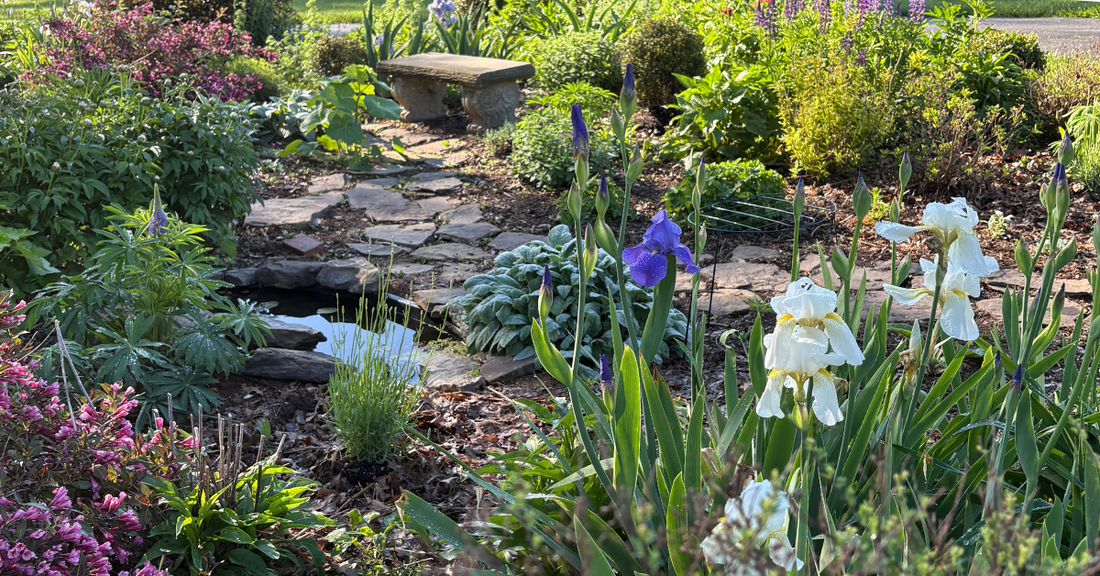
If you want to turn your property into an ecosystem for diverse wildlife, you can’t forget about a wildlife pond! In addition to your cottage garden, vegetable garden, meadow, and orchard, this small body of water is a must-have for a naturalist backyard. Shall we jump into the benefits of wildlife ponds and why you should install one? Let’s go!
What is a Wildlife Pond?
A wildlife pond is a small, purposefully created body of water in your backyard that serves as a haven for local flora and fauna. Unlike traditional ornamental ponds, wildlife ponds are designed with a focus on supporting and attracting various wildlife species, from amphibians and insects to birds and mammals. They’re designed to do so naturally with natural bacteria, sunlight, and aquatic plants.

What Makes a Wildlife Pond Different from a Regular Backyard Pond?
Native Plant Life
Wildlife ponds boast a diverse array of native aquatic plants, such as water lilies, water forget-me-nots, and marsh marigolds. These plants provide shelter, breeding sites, and food sources for different aquatic species. They’re also key elements to keeping your pond healthy and oxygenated.
Shallow Edges and Curving Shoreline
The edges of a wildlife pond are often gently sloped or feature shallow shelves. These areas are crucial for amphibians like frogs and newts, as they offer easy access to and from the water for breeding and foraging.
The more surface area you have on the shoreline of your wildlife pond, the better! This will give different animals and insects places to thrive.
Varied Depths
A well-designed wildlife pond typically has a variety of depths. Deeper areas provide hibernation zones for frogs, and shallower waters allow easy entrance and exit from the water as well as a place for many bugs and birds to take baths.
Natural Materials
Wildlife ponds often utilize natural materials for construction, such as clay, sand, and gravel. These materials help create a suitable habitat for different aquatic organisms and promote a healthy ecosystem. However, you will need to purchase a heavy duty pond liner to go underneath your substrate.

No Fish (usually)
Unlike ornamental ponds, wildlife ponds are fish-free. Fish can be voracious predators of tadpoles, insect larvae, and other small aquatic creatures, which could disrupt the delicate balance of the ecosystem. You’ll also need a lot bigger pond with a greater depth if you intend on keeping fish. You’d better opt for a traditional fish pond, if so.
Water Circulation
Wildlife ponds are completely self sustaining with barley straw for algea control, mosquito dunks to prevent larvae from hatching, and pond plants to filter and clarify the water. The plants and nature microbiome will also help balance pond health. You do not need a filter, running water, or a pump with a wildlife pond! With proper planting and time, your wildlife pond will balance itself naturally.
The Benefits of Wildlife Ponds
Biodiversity
One of the most significant advantages of having a wildlife pond is the increase in biodiversity it brings to your backyard. These ponds act as a magnet for a wide range of species, from tiny insects and amphibians to birds and mammals. They provide vital habitats for these creatures, contributing to the conservation of local biodiversity.
Keep your eye out in the early morning and at dusk to see what animals stop by. Better yet, install a game camera to glimpse nighttime visitors.
Pollinator Paradise
Wildlife ponds attract a plethora of pollinators, including bees, butterflies, and other insects. The native aquatic plants serve as nectar and pollen sources, supporting pollinator populations and enhancing the pollination of nearby plants, including those in your garden.

Natural Pest Control
Many of the creatures attracted to wildlife ponds are natural predators of pests that could otherwise harm your garden. For example, frogs and toads devour garden pests like slugs and insects, helping to keep their populations in check without the need for chemical pesticides.
Dragonflies also lay their eggs in ponds, and their hungry babies gobble up mosquitos. With a fresh water source, you may also attract more bats which feast on mosquitos.
Educational Opportunities
A wildlife pond in your backyard provides an excellent opportunity for learning and observation. Children and adults alike can study the fascinating life cycles of various aquatic creatures, gaining a deeper appreciation for the intricacies of nature and the interconnectedness of ecosystems.
Emotional Well-being
The calming sound of trickling water, the sight of dragonflies skimming the surface, and the sight of birds drinking and bathing can all contribute to a sense of peace and tranquility in your backyard. Wildlife ponds provide a serene and soothing environment, reducing stress and promoting emotional well-being.
Water Conservation
Once established, these self-sustaining ecosystems require little to no supplemental watering, thus promoting water conservation. You may even be able to install a rain garden nearby your pond for overflow during storms.
Carbon Sequestration
Like any natural ecosystem, a healthy wildlife pond contributes to carbon sequestration by capturing and storing carbon dioxide from the atmosphere. Aquatic plants and submerged organic matter play a role in this process, making your backyard a small yet meaningful contributor to mitigating climate change.
Wildlife ponds are a delightful and environmentally responsible addition to any backyard. By embracing the key characteristics of native plant life, shallow edges, varied depths, natural materials, and avoiding fish, you can create a thriving ecosystem that supports a plethora of wildlife.
From boosting biodiversity and promoting pollination to providing natural pest control and offering educational and emotional benefits, wildlife ponds are a testament to the wonders of nature and the positive impact we can have on our environment, even in our own backyards. So, dive into the joys of wildlife ponds, and let the magic of nature unfold before your very eyes!

